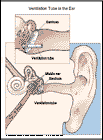
Ear Tube Surgery
Admission Information and Discharge Instructions
What are ear tubes?
Ear tubes are known by many names, including tympanostomy tubes, ear ventilating tubes, or, most often, PE (pressure-equalizing) tubes. The tiny hollow tubes are made of soft plastic and are often shaped like small sewing bobbins. These tubes are placed in your child's eardrums and reduce the number of ear infections by letting air into the middle ear while draining fluid out. Keeping this fluid out of the middle ear can help bring back normal hearing. The tubes do not cause hearing loss or long-term damage to the eardrum.
What happens during surgery?
PE tubes are put in during day surgery. Your child does not have to stay overnight in the hospital. Your child will have general anesthesia and will be asleep through the surgery. Using a microscope, the ear surgeon makes a small cut in the eardrum. Any fluid in the middle ear is removed. The tube is put in the eardrum hole and stays in place without any stitches.
Surgery on both eardrums takes less than 20 minutes. Recovery from anesthesia is rapid and your child will be able to go home in about 1 hour.
When will my child's hearing improve?
Many children can hear better right away after the ear tubes have been put in. The child may be frightened by normal noises that now seem loud. This will go away as soon as your child gets used to hearing normal sound volumes.
How can I take care of my child?
- Pain Medicine. Your child may need medicine the first few days after surgery for pain control. Your child's pain medicine is ______________________. Give __________ every ______ hours as needed.
- Diet. Your child may feel sick to his stomach or throw up right after surgery. First give your child cool, clear liquids to drink. As your child feels like eating, slowly return to a normal diet.
- Ear Drainage after Surgery. Because an opening in the
eardrum has been made, you may see drainage from the
middle ear for 2 to 3 days after the operation. The
drainage may be clear, pink, or bloody. The doctor may
give you some medicine drops for this.
Your child's medicine is ________________________. Put 3 drops in each ear 3 times a day for 3 days. These drops may sting a little for some children. If the stinging makes your child too uncomfortable, you may stop the drops.
- Protection from Water. After the ear tubes are in place, try to keep water out of the ears. Often there won't be a problem if water does get in the ears, but water can carry germs into the middle ear through the tube and cause an ear infection. During bathing, shampooing, and swimming, your child's ears should be protected. Vaseline coated cotton balls, silicone ear putty, or specially made ear molds can be placed in the outer ear to block the ear canal. Silly Putty should not be used because pieces can be left in the ear canal. Either ear putty or ear molds should be used when swimming. No diving.
- Ear Infections. PE tubes will help stop ear infections
most of the time. However, an ear infection can still
occur. You should call the office nurse if your child
ever has ear pain, fullness in the ears, hearing
problems, or drainage or blood from the ears (except just
after surgery). Often the nurse can tell over the phone
if the child can be treated at home with medicine by
mouth or ear drops, or if the child needs to be seen in
the office.
You can decrease the chance that your child will have an ear infection if you:
- feed your child in a sitting up position
- do not let your child go to bed with a bottle
- avoid having your child around anyone who is smoking.
- Tube Removal. Almost all PE tubes are slowly pushed out of the eardrums and fall out of the ear. This usually happens 6 to 12 months after surgery. Very rarely tubes need to be taken out in a surgery. Most children (85%) will not need a second set of PE tubes put in. By the time the tubes have fallen out, most children have outgrown the need for tubes.
- Other Medicines
- For pain or fever over 102°F (39°C) give ________________________
- _______________________________________________________
- ________________________________________________________
- Additional Instructions
__________________________________________________________
__________________________________________________________
__________________________________________________________
- Follow-up Appointment After Discharge
Your child needs to be rechecked and has an appointment on ______________ at ________ o'clock with _______________________.
Call Your Ear, Nose, and Throat (ENT) Doctor Immediately If:
- Your child's vomiting lasts more than 24 hours.
- Your child has any signs of dehydration.
- The pain is not helped by pain medicine.
Call Your ENT Doctor During Office Hours If:
- Ear drainage lasts more than 3 days.
- You have other questions or concerns.

